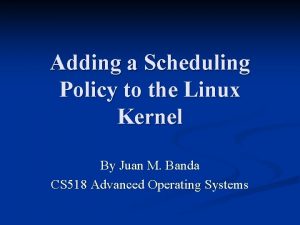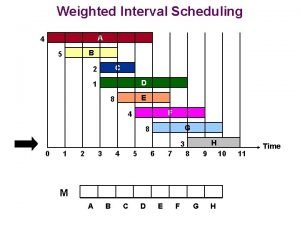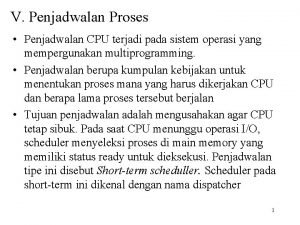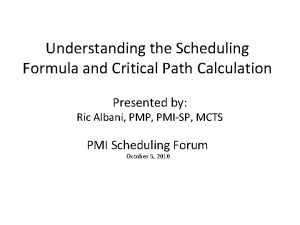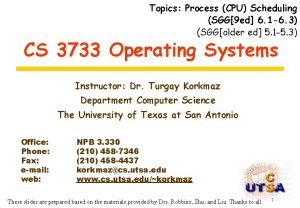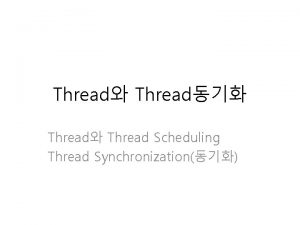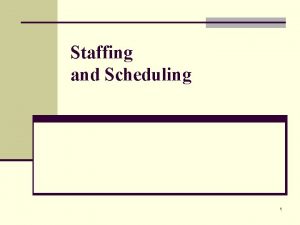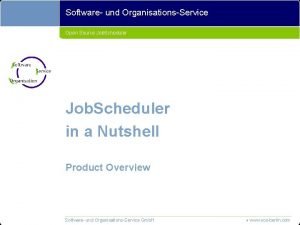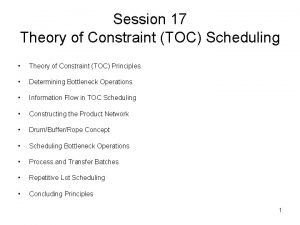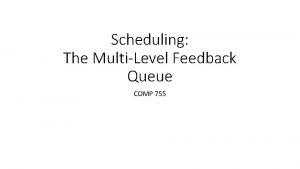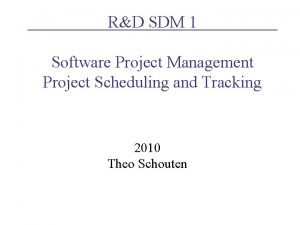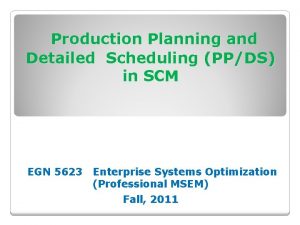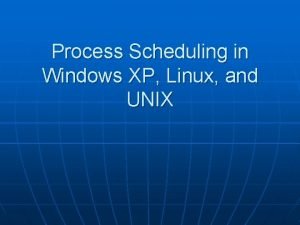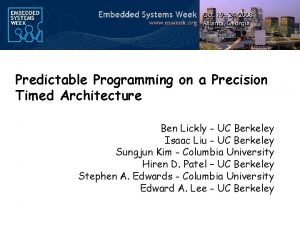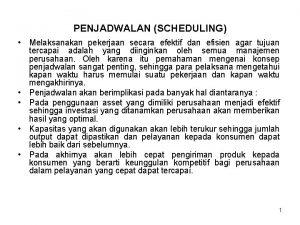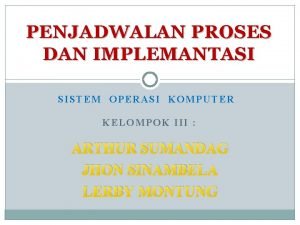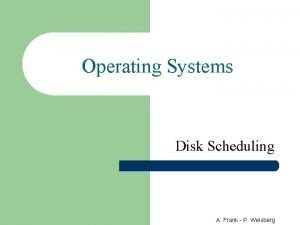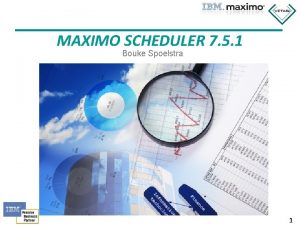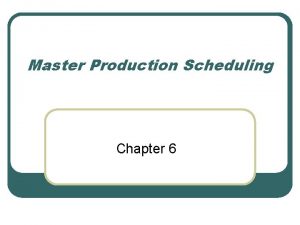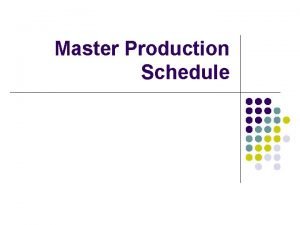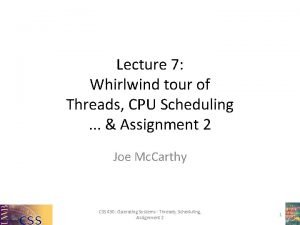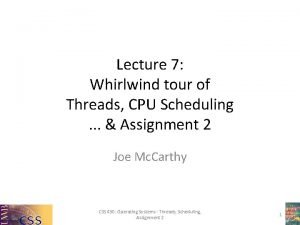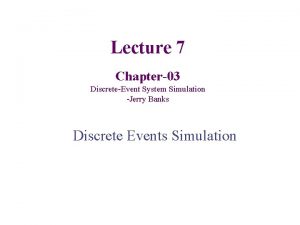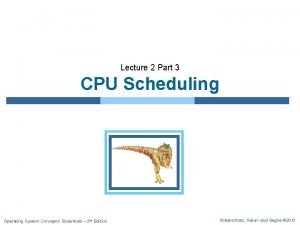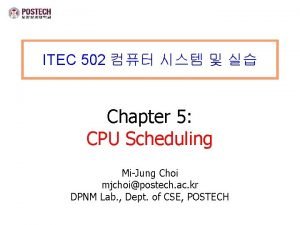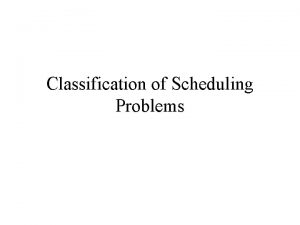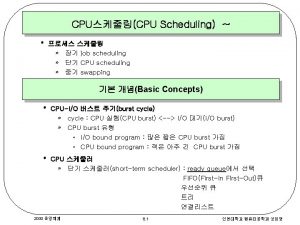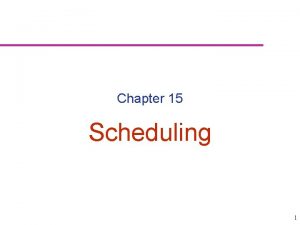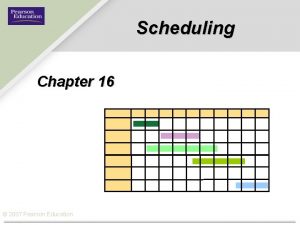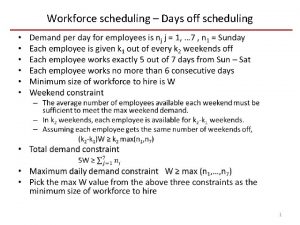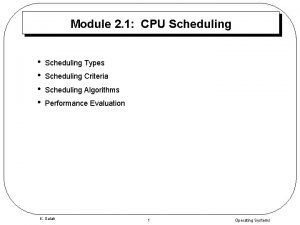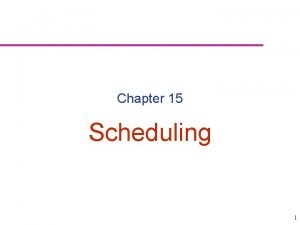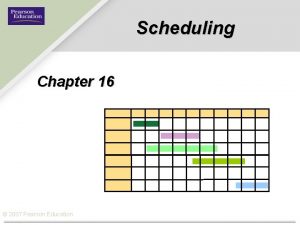Scheduling Main Points Scheduling policy what to do






















































- Slides: 54

Scheduling

Main Points • Scheduling policy: what to do next, when there are multiple threads ready to run – Or multiple packets to send, or web requests to serve, or … • Definitions – response time, throughput, predictability • Uniprocessor policies – FIFO, round robin, optimal – multilevel feedback as approximation of optimal • Multiprocessor policies – Affinity scheduling, gang scheduling • Queueing theory – Can you predict/improve a system’s response time?

Example • You manage a web site, that suddenly becomes wildly popular. Do you? – Buy more hardware? – Implement a different scheduling policy? – Turn away some users? Which ones? • How much worse will performance get if the web site becomes even more popular?

Definitions • Task/Job – User request: e. g. , mouse click, web request, shell command, … • Latency/response time – How long does a task take to complete? • Throughput – How many tasks can be done per unit of time? • Overhead – How much extra work is done by the scheduler? • Fairness – How equal is the performance received by different users? • Predictability – How consistent is the performance over time?

More Definitions • Workload – Set of tasks for system to perform • Preemptive scheduler – If we can take resources away from a running task • Work-conserving – Resource is used whenever there is a task to run – For non-preemptive schedulers, work-conserving is not always better • Scheduling algorithm – – takes a workload as input decides which tasks to do first Performance metric (throughput, latency) as output Only preemptive, work-conserving schedulers to be considered

First In First Out (FIFO) • Schedule tasks in the order they arrive – Continue running them until they complete or give up the processor • Example: memcached – Facebook cache of friend lists, … • On what workloads is FIFO particularly bad?

Shortest Job First (SJF) • Always do the task that has the shortest remaining amount of work to do – Often called Shortest Remaining Time First (SRTF) • Suppose we have five tasks arrive one right after each other, but the first one is much longer than the others – Which completes first in FIFO? Next? – Which completes first in SJF? Next?

FIFO vs. SJF

Question • Claim: SJF is optimal for average response time – Why? • Does SJF have any downsides?

Question • Is FIFO ever optimal? • Pessimal?

Starvation and Sample Bias • Suppose you want to compare two scheduling algorithms – Create some infinite sequence of arriving tasks – Start measuring – Stop at some point – Compute average response time as the average for completed tasks between start and stop • Is this valid or invalid?

Sample Bias Solutions • Measure for long enough that # of completed tasks >> # of uncompleted tasks – For both systems! • Start and stop system in idle periods – Idle period: no work to do – If algorithms are work-conserving, both will complete the same tasks

Round Robin • Each task gets resource for a fixed period of time (time quantum) – If task doesn’t complete, it goes back in line • Need to pick a time quantum – What if time quantum is too long? • Infinite? – What if time quantum is too short? • One instruction?

Round Robin

Round Robin vs. FIFO • Assuming zero-cost time slice, is Round Robin always better than FIFO?

Round Robin vs. FIFO

Round Robin = Fairness? • Is Round Robin always fair? • What is fair? – FIFO? – Equal share of the CPU? – What if some tasks don’t need their full share? – Minimize worst case divergence? • Time task would take if no one else was running • Time task takes under scheduling algorithm

Mixed Workload

Max-Min Fairness • How do we balance a mixture of repeating tasks: – Some I/O bound, need only a little CPU – Some compute bound, can use as much CPU as they are assigned • One approach: maximize the minimum allocation given to a task – If any task needs less than an equal share, schedule the smallest of these first – Split the remaining time using max-min – If all remaining tasks need at least equal share, split evenly

Multi-level Feedback Queue (MFQ) • Goals: – Responsiveness – Low overhead – Starvation freedom – Some tasks are high/low priority – Fairness (among equal priority tasks) • Not perfect at any of them! – Used in Linux (and probably Windows, Mac. OS)

MFQ • Set of Round Robin queues – Each queue has a separate priority • High priority queues have short time slices – Low priority queues have long time slices • Scheduler picks first thread in highest priority queue • Tasks start in highest priority queue – If time slice expires, task drops one level

MFQ

Uniprocessor Summary (1) • FIFO is simple and minimizes overhead. • If tasks are variable in size, then FIFO can have very poor average response time. • If tasks are equal in size, FIFO is optimal in terms of average response time. • Considering only the processor, SJF is optimal in terms of average response time. • SJF is pessimal in terms of variance in response time.

Uniprocessor Summary (2) • If tasks are variable in size, Round Robin approximates SJF. • If tasks are equal in size, Round Robin will have very poor average response time. • Tasks that intermix processor and I/O benefit from SJF and can do poorly under Round Robin.

Uniprocessor Summary (3) • Max-Min fairness can improve response time for I/O-bound tasks. • Round Robin and Max-Min fairness both avoid starvation. • By manipulating the assignment of tasks to priority queues, an MFQ scheduler can achieve a balance between responsiveness, low overhead, and fairness.

Multiprocessor Scheduling • What would happen if we used MFQ on a multiprocessor? – Contention for scheduler spinlock – Cache slowdown due to ready list data structure pinging from one CPU to another – Limited cache reuse: thread’s data from last time it ran is often still in its old cache

Per-Processor Affinity Scheduling • Each processor has its own ready list – Protected by a per-processor spinlock • Put threads back on the ready list where it had most recently run – Ex: when I/O completes, or on Condition->signal • Idle processors can steal work from other processors

Per-Processor Multi-level Feedback with Affinity Scheduling

Scheduling Parallel Programs • What happens if one thread gets time-sliced while other threads from the same program are still running? – Assuming program uses locks and condition variables, it will still be correct – What about performance?

Bulk Synchronous Parallelism • Loop at each processor: – Compute on local data (in parallel) – Barrier – Send (selected) data to other processors (in parallel) – Barrier • Examples: – Map. Reduce – Fluid flow over a wing – Most parallel algorithms can be recast in BSP • Sacrificing a small constant factor in performance

Tail Latency

Scheduling Parallel Programs Oblivious: each processor time-slices its ready list independently of the other processors

Gang Scheduling

Parallel Program Speedup

Space Sharing Scheduler activations: kernel tells each application its # of processors with upcalls every time the assignment changes

Queueing Theory • Can we predict what will happen to user performance: – If a service becomes more popular? – If we buy more hardware? – If we change the implementation to provide more features?

Queueing Model Assumption: average performance in a stable system, where the arrival rate (ƛ) matches the departure rate (μ)

Definitions • Queueing delay (W): wait time – Number of tasks queued (Q) • Service time (S): time to service the request • Response time (R) = queueing delay + service time • Utilization (U): fraction of time the server is busy – Service time * arrival rate (ƛ) • Throughput (X): rate of task completions – If no overload, throughput = arrival rate

Little’s Law N=X*R N: number of tasks in the system Applies to any stable system – where arrivals match departures.

Question Suppose a system has throughput (X) = 100 tasks/s, average response time (R) = 50 ms/task • How many tasks are in the system on average? • If the server takes 5 ms/task, what is its utilization? • What is the average wait time? • What is the average number of queued tasks?

Question • From example: X = 100 task/sec R = 50 ms/task S = 5 ms/task W = 45 ms/task Q = 4. 5 tasks • Why is W = 45 ms and not 4. 5 * 5 = 22. 5 ms? – Hint: what if S = 10 ms? S = 1 ms?

Queueing • What is the best case scenario for minimizing queueing delay? – Keeping arrival rate, service time constant • What is the worst case scenario?

Queueing: Best Case

Response Time: Best vs. Worst Case

Queueing: Average Case? • What is average? – Gaussian: Arrivals are spread out, around a mean value – Exponential: arrivals are memoryless – Heavy-tailed: arrivals are bursty • Can have randomness in both arrivals and service times

Exponential Distribution

Exponential Distribution Permits closed form solution to state probabilities, as function of arrival rate and service rate

Response Time vs. Utilization

Question • Exponential arrivals: R = S/(1 -U) • If system is 20% utilized, and load increases by 5%, how much does response time increase? • If system is 90% utilized, and load increases by 5%, how much does response time increase?

Variance in Response Time • Exponential arrivals – Variance in R = S/(1 -U)^2 • What if less bursty than exponential? • What if more bursty than exponential?

What if Multiple Resources? • Response time = Sum over all i Service time for resource i / (1 – Utilization of resource i) • Implication – If you fix one bottleneck, the next highest utilized resource will limit performance

Overload Management • What if arrivals occur faster than service can handle them – If do nothing, response time will become infinite • Turn users away? – Which ones? Average response time is best if turn away users that have the highest service demand – Example: Highway congestion • Degrade service? – Compute result with fewer resources – Example: CNN static front page on 9/11

Highway Congestion (measured)

Why Do Metro Buses Cluster? • Suppose two Metro buses start 15 minutes apart – Why might they arrive at the same time?
 Job scheduling vs process scheduling
Job scheduling vs process scheduling Linux scheduling policy
Linux scheduling policy Straddle positioning example
Straddle positioning example Points of parity and points of difference
Points of parity and points of difference Main points of federalist 78
Main points of federalist 78 Letter from birmingham jail summary
Letter from birmingham jail summary Lahore resolution 1940 main points in urdu
Lahore resolution 1940 main points in urdu Main points of federalist 78
Main points of federalist 78 What is a supporting point
What is a supporting point Redemptor hominis
Redemptor hominis The spatial strategy of organizing your speech
The spatial strategy of organizing your speech Multi-channeled definition in communication
Multi-channeled definition in communication Verbal intercultural communication
Verbal intercultural communication Essay on self reliance in english
Essay on self reliance in english Subpoints in a preparation outline are
Subpoints in a preparation outline are Will-future
Will-future Example of main idea
Example of main idea Void main int main
Void main int main Weighted interval scheduling
Weighted interval scheduling Time sharing
Time sharing Critical path formula
Critical path formula Difference between preemptive and nonpreemptive scheduling
Difference between preemptive and nonpreemptive scheduling Thread scheduling
Thread scheduling Staffing and scheduling in nursing
Staffing and scheduling in nursing Enterprise scheduler open source
Enterprise scheduler open source Toc scheduling
Toc scheduling Foxwoods dealer scheduling
Foxwoods dealer scheduling Script breakdown sheets
Script breakdown sheets Mlfq scheduling
Mlfq scheduling What are the impacts of resource constrained scheduling
What are the impacts of resource constrained scheduling Dental office scheduling template
Dental office scheduling template Forward scheduling in sap sd
Forward scheduling in sap sd Sdm in project management
Sdm in project management Forward pass scheduling
Forward pass scheduling Production planning and inventory control
Production planning and inventory control Product planning and detailed scheduling
Product planning and detailed scheduling Windows process scheduling algorithm
Windows process scheduling algorithm Memory access pattern
Memory access pattern Contoh penjadwalan scheduling
Contoh penjadwalan scheduling Penjadwalan proses sistem operasi
Penjadwalan proses sistem operasi Difference between preemptive and nonpreemptive scheduling
Difference between preemptive and nonpreemptive scheduling Disk scheduling in operating system
Disk scheduling in operating system Multilevel queue scheduling example with gantt chart
Multilevel queue scheduling example with gantt chart Round robin scheduling example
Round robin scheduling example Cyclic executive
Cyclic executive Scheduler plus
Scheduler plus Maximo assignment manager application
Maximo assignment manager application Master production schedule problems
Master production schedule problems What is master production schedule
What is master production schedule Thread scheduling
Thread scheduling Thread scheduling
Thread scheduling Manual simulation using event scheduling
Manual simulation using event scheduling Scheduling in batch system
Scheduling in batch system Sjf cpu scheduling
Sjf cpu scheduling Sjf cpu scheduling
Sjf cpu scheduling

